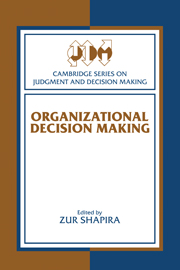Book contents
- Frontmatter
- Contents
- Series preface
- List of contributors
- Editor's preface
- Part I Introduction
- Part II Information processing and attention allocation
- 3 Trying to help S&Ls: How organizations with good intentions jointly enacted disaster
- 4 Organizational choice under ambiguity: Decision making in the chemical industry following Bhopal
- 5 Strategic agenda building in organizations
- Part III Preference processing
- Part IV Decision processes
- Part V Alternative approaches
- Name index
- Subject index
5 - Strategic agenda building in organizations
Published online by Cambridge University Press: 06 August 2010
- Frontmatter
- Contents
- Series preface
- List of contributors
- Editor's preface
- Part I Introduction
- Part II Information processing and attention allocation
- 3 Trying to help S&Ls: How organizations with good intentions jointly enacted disaster
- 4 Organizational choice under ambiguity: Decision making in the chemical industry following Bhopal
- 5 Strategic agenda building in organizations
- Part III Preference processing
- Part IV Decision processes
- Part V Alternative approaches
- Name index
- Subject index
Summary
Some issues get attention in organizations and others do not. For example, in some organizations, in some industries, issues of sustainable development and the natural environment dominate the organization's strategic agenda. In other organizations, in the same or different industries, issues of the natural environment have never been broached or thought about by organizational members. I could make the same comparisons between organizations, looking at very different kinds of issues: regulatory issues, human resource issues, competitor issues, and issues of new technology. Why is this so? What is the process by which issues reach an organization's strategic agenda? Why does strategic agenda building matter for understanding the process of decision making in organizations?
The goal of this chapter is to address these questions by elaborating four different perspectives on agenda-building processes, all of which are implicitly or explicitly in currency within organizational studies. Perspective 1 looks at agenda building as the product of top management's perceptions. Perspective 2 emphasizes that middle managers are active agents in the construction of strategic issues for the organization. Perspective 3 depicts agenda building as the activation of organizational routines. Finally, perspective 4 portrays agenda building as an intraorganizational ecological process. I describe each perspective and extract important insights that each perspective provides for thinking about strategic agenda-building processes. I conclude the chapter with a discussion of what an agenda-building perspective adds to the way organizational scholars and practitioners think about decision making.
- Type
- Chapter
- Information
- Organizational Decision Making , pp. 81 - 108Publisher: Cambridge University PressPrint publication year: 1996
- 5
- Cited by



